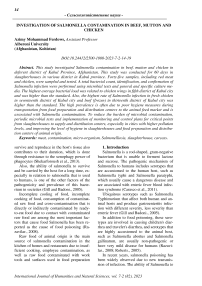Investigation of salmonella contamination in beef, mutton and chicken
Автор: Azimy M.F.
Журнал: Международный журнал гуманитарных и естественных наук @intjournal
Рубрика: Сельскохозяйственные науки
Статья в выпуске: 7-2 (82), 2023 года.
Бесплатный доступ
This study investigated Salmonella contamination in beef, mutton and chicken in deferent district of Kabul Province, Afghanistan. This study was conducted for 60 days in slaughterhouses in various district in Kabul province. Forty-five samples, including red meat and chicken, were sampled and tested. A total bacterial count, identification, and confirmation of Salmonella infection were performed using microbial tests and general and specific culture media. The highest average bacterial load was related to chicken wings in fifth district of Kabul city and was higher than the standard. Also, the highest rate of Salmonella infection in fresh chicken in seventeenth district of Kabul city and beef (frozen) in thirteenth district of Kabul city was higher than the standard. The high prevalence is often due to poor hygiene measures during transportation from food preparation and distribution centers to the animal feed market and is associated with Salmonella contamination. To reduce the burden of microbial contamination, periodic microbial tests and implementation of monitoring and control plans for critical points from slaughterhouses to supply and distribution centers, especially in cities with higher pollution levels, and improving the level of hygiene in slaughterhouses and food preparation and distribution centers of animal origin.
Meat, contamination, microorganism, salmonelliosis, slaughterhouse, carcass
Короткий адрес: https://sciup.org/170200613
IDR: 170200613 | DOI: 10.24412/2500-1000-2023-7-2-14-19
Список литературы Investigation of salmonella contamination in beef, mutton and chicken
- Carasco E, Rueda AM, Gimeno AM, (2011). Gimeno R. Cross- contamination and recontamination by salmonella in food: A review. Food Research international.; 45:545-556.
- Gill CO and Badoni M. (2005). Recovery of bacteria from poultry carcasses by rinsing, swabbing or excision of skin.Food Microbiology.; 22:101-107.
- Hamedi AAR, Parizadeh SMJ, Ghanaat J. study of contamination to salmonella in two groups egg (compiercial and local). Article. Medical journal of mashhad university of medical sciences. 2002;45(76):67-71.
- Hossein nezhad yazdi N, Ahari H, Akhondzadeh A. Effect of washing and transportation of chicken carcasses at different temperatures from the west of Tehran to the supply site. Journal of Food Microbiology. 2017; 4(2): 45-56.
- Iranian Institute of Standards and Industrial Research, (1992). Salmonella Search and Identification Method, Iranian National Standard 1810.
- Iranian Institute of Standards and Industrial Research, (1992). The permissible limit of microbial contamination in various types of meat, standard number 2394.
- Iranian Institute of Standards and Industrial Research, (1992). General Guide for Implementing the Hazard Analysis System, Critical Control Points (HACCP) in Complete Red Meat and Poultry Meat Production Units (Production, Packaging, Marking), Iranian National Standard 6165.
- Jamshidi A, Zahraei-Salehi T, Afshari-Nic S. (2007). Detection of Salmonella spp. contamination of carcasses slaughtered in poultry abattoir in Mashhad, Iran. Archives of Razi Institute.; 62:229-233.
- Javadi A, Razavilar V. (2007). Study on microbial hazards of poultry slaughterhouse with HACCP system. Pajouhesh & Sazandegi.; 74:40-45.
- Kafili T, Emam JZ, Kazerouni TM. (2006). Study to Determine the Critical Control Points in Beef Slaughter Line in order to Establish a HACCP system. mdrsjrns.;3 (9):35-47.
- Mofidi M, Shokoohmand M, Saeedabadi M, Ebadi Z. Evaluation of Carcass Quality for Coliforms, Salmonella and Psychrophiles on Evisceration and Chiller lines in Yazd Province Industrial Poultry Slaughterhouses. Research. Tolooebehdasht. 2014; 13(1):22-29.
- Morar A, Milovan G.H, Sala C, Stanchescu I. (2008). Establishing the bacterial control points in poultry slaughterhouse, MedicinaVeterinara; 41:704-708.
- Niazi S, Rokni N, Razavilar V, Bahonar AR, Akhondzadeh A. Qualitative and quantitative assessment of poultry carcasses contaminated with salmonella in Tehran industrial slaughterhouses. Journal of Veterinary Research. 2007; 62(4):385-9.
- PajohiAlamoti M., Mohammadzadeh A, Khanjari A. (2014). A survey on microbial contamination of broiler carcass during processing in Hamedan industrial abattoir. Veterinary Researches & Biological Products; 27(2):8-13. DOI: 10.22092/vj.2014.100976.
- Razavilar V. (2008). Pathogenic microbes in food and the epidemiology of food poisoning, University of Tehran Press, 84-90.
- Roberts T. (2005). Economics of private strategies to control food borne pathogens. Choices 2nd Quarter, 20(2): 117-122.
- Shekarforoush SS, Kiaie SM, Karim G, RazaviRohani SM, Rokni N, Abbasvali M. (2013). Study on the overview on foodborne bacteria in food with animal origin in Iran; Part four: Poultry and egg. Food Hygiene; 3(1(9)):45-64.
- Soltan D MM, Motalebi S, MasoomiAsl H, RahimiForoushani A, SharifiYazdi MK, Aghili N. (2015). Investigation of the frequency of Salmonella Spp. in foodborne disease outbreaks in Iran and determination of their antibiotic resistance. Pajoohandeh; 19(6):341-347.
- Talebi Z, PayamiKhamiran M.(2014). Investigation and comparison of microbial contamination of red meat, poultry and fish in food packaging and distribution companies, National Conference on Health and Food Industry, Ahvaz Jundishapur University of Medical Sciences.
- Tsola, E., Drosinos, E.H. and Zoiopoulos, P. (2008). Impact of poultry slaughter house modernisation and updating of food safety management systems on the microbiological quality and safety of products. Food Control;19: 423-431.
- Zahedi M, Rahimi E, zahedi M, Momtaz H, Shojaii H. (2017). Prevalence of Salmonella enteritidis and S.typhimurium in marketed meat in Shahrekord in 2014. Journal of Shahrekor-dUuniversity of Medical Sciences; 19(2):88-97.


